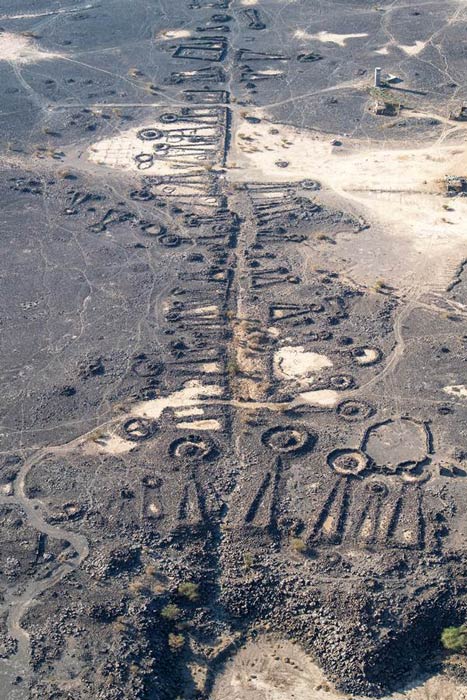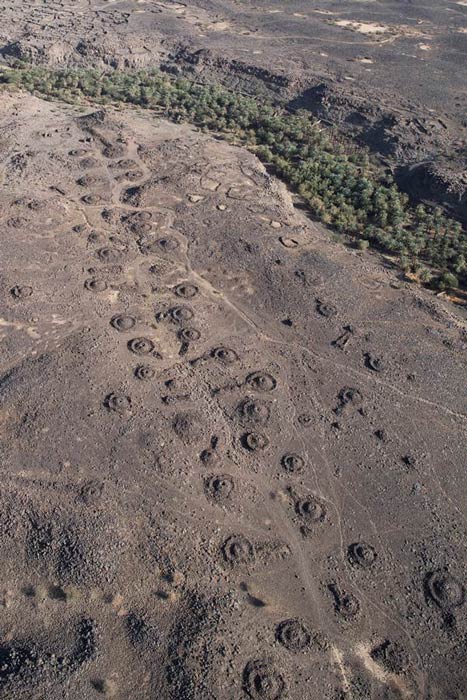The modern fascination with highways is not as modern as it seems. Throughout history, there have been examples of building and constructing routes, particularly along important trading routes linking far off settlements. All ancient empires had these “highways.” Now a new discovery has been made along these lines in Saudi Arabia’s Arabian Peninsula in which a 4,500-year-old network of funerary avenues have been mapped and investigated. The new study, published in the The Holocene journal, suggests “a high degree of socio-economic connection in the third millennium BC.”
In the abstract of the recent Holocene journal study, the researchers write:
“The desert regions of the Arabian Peninsula and Levant are criss-crossed by innumerable pathways. Across large areas of north-west Arabia, many of these pathways are flanked by stone monuments, the vast majority of which are ancient tombs. Recent radiometric dating indicates that the most abundant of these monuments, elaborate and morphologically diverse ‘pendant’ structures, were constructed during the mid-to-late third millennium BCE. Thousands of kilometres of these composite path and monument features, ‘funerary avenues’, can be traced across the landscape…”
The team of researchers and archaeologists from the University of Western Australia (UWA) used satellite imagery, aerial photography, ground surveys, and excavation data from a vast 160,000-square-kilometer (61,776-square-mile) area stretching across northwestern Saudi Arabia. The discovery is part of a 15-year project known as “ The Journey Through Time ” aiming to reintroduce the AlUla and Khaybar areas as global centers of natural, cultural, and social heritage reports The Siasat Daily .

This Khaybar corridor funerary avenue in northwestern Saudi Arabia is in plain sight when you look at this incredible aerial photograph. ( Royal Commission for AlUla )
The Funerary Avenues of Saudi Arabia Are Amazing!
The latest study of the funerary avenues of Saudi Arabia has shown that these routes were organized and connected by major riverine and other perennial sources of water. Moreover, important aspects of human mobility, organization, commerce, and interconnectedness across this ancient region are now better understood from the study’s conclusions. Two extremely relevant contemporary issues, human interactions with the environment and the Anthropocene climate crisis , are also covered in the study.
The study also looked at subsistence strategies practiced in the settlements along the funerary avenues, particularly those of nomadic pastoralists . Nomads were adept at developing oasis-centered settlements, which developed into long lasting settlements. This revealed an enhanced understand of ancient human migratory patterns , and traditional ways of communal living and survival, particularly in environments that can change for the worse.
“Our findings demonstrate that these structures linked various populated oases, situated across a vast area and that the funerary avenues were established around 4,500 years ago. They are especially dense around Khaybar, which is one of the densest visible funerary landscapes anywhere in the world,” said project director Professor Hugh Thomas to The National News . Professor Thomas has been associated with extensive archaeological work and research in northwestern Saudi Arabia over the last few years.

Ancient funerary tombs along the amazing funerary avenues of Saudi Arabia, revealed in a recent research study. ( Royal Commission for AlUla )
The Monuments Along Saudi Arabia’s Funerary Avenues
The monuments along Saudi Arabia’s funerary avenues or highways occur in varying densities and sizes. Ringed and un-ringed cairns, small circular towers, and tailed pendant-shaped structures were the most numerous: 17,800 in total! They have been identified as tombs based on their stone-lined burial chambers .
Pendant structures have revealed human remains at these sites dating to the 3rd millennium BC (30th-21st century BC). Of the 17,800 structures identified 11,000 were pendant structures that were linked along the funerary avenues.
The study’s key socio-economic takeaway regarding trade and commerce indicates that the oases served as intermediary points along primary corridors, which included Khaybar, AlUla, and Tayma. Clearly, these routes were used to transport herds of domestic animals to nearby pastures during periods of rain.
Professor Hugh Thomas noted that, “Our findings demonstrate that these structures linked various populated oases, situated across a vast area, and that the funerary avenues were established around 4,500 years ago. They are especially dense around Khaybar, which is one of the densest visible funerary landscapes anywhere in the world.”
Dr Jasir Alherbish, CEO of the Saudi Heritage Commission told The National that the commission wants to preserve Saudi heritage and “share this legacy with the world” by launching new initiatives.
Over the last ten years, Saudi Arabia has been aggressive in its efforts to capture, preserve, and document the vast history of this modern desert state as a global center for historical study and archaeological work. The pandemic notwithstanding, the commission plans to invite foreign researchers and archaeologists to work on this project through state-sponsored research and archaeology.
Top image: An amazing new study has charted the funerary avenues across northwestern Saudi Arabia using satellite images, aerial photography and more! Source: Royal Commission for AlUla
By Sahir Pandey
Related posts:
Views: 0
 RSS Feed
RSS Feed

















 January 13th, 2022
January 13th, 2022  Awake Goy
Awake Goy 




 Posted in
Posted in  Tags:
Tags: 
















